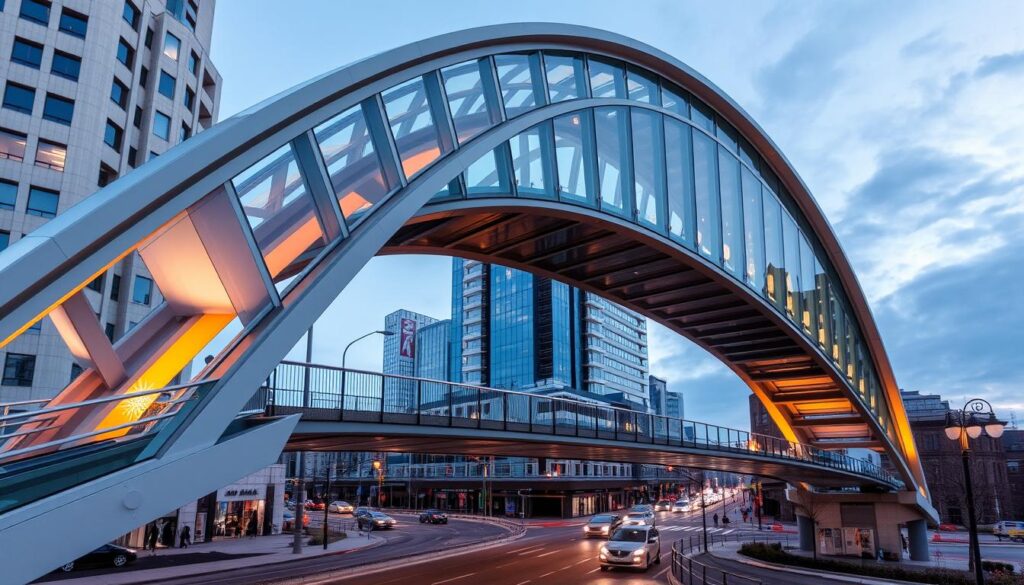Can a simple structure like a pedestrian bridge truly transform the urban landscape? The answer lies in the way these bridges connect communities, foster accessibility, and showcase architectural innovation. Pedestrian bridges worldwide stand as symbols of connectivity and architectural ingenuity, embodying the urban experience for its core users.
Examples like the ones featured on ArchDaily illustrate how urban connectivity is enhanced through thoughtful design, highlighting the role of these structures in shaping the urban experience.
Key Takeaways
- Pedestrian bridges play a crucial role in enhancing urban connectivity.
- Thoughtful design can transform the urban landscape.
- These structures foster community engagement and accessibility.
- Architectural innovation is showcased through unique bridge designs.
- Urban connectivity is vital for a cohesive community.
Introduction to Pedestrian Bridge Design
Pedestrian bridges play a crucial role in enhancing urban connectivity and revitalizing city landscapes. They are not just structures; they are vital components that contribute to the aesthetic and functional appeal of urban environments.
The significance of pedestrian bridges is evident in their ability to connect communities, promote walkability, and support local businesses. Innovative pedestrian bridge design has become a key factor in urban planning, as seen in projects like the Kusugibashi Bridge in Japan and the Hangzhou Riverfront Public Space’s Silk Bridge, which showcase urban connectivity through waterfront revitalization.
Importance of Pedestrian Bridges
Pedestrian bridges are essential for ensuring the safety and mobility of pedestrians in urban areas. They provide a safe crossing point over busy roads, railways, or waterways, thereby reducing the risk of accidents and enhancing overall urban livability. The design of these bridges must consider various factors, including accessibility, safety, and aesthetic appeal, to create structures that are both functional and pleasing to the eye.
For more insights into designing pedestrian bridges, you can explore resources like Designing a Pedestrian Bridge on Instructables, which provides detailed guides and tutorials.
Benefits for Urban Planning
The benefits of pedestrian bridges in urban planning are multifaceted. They not only improve pedestrian safety and accessibility but also contribute to the urban landscape’s visual appeal. Well-designed pedestrian bridges can become landmarks, enhancing the character of a city and promoting tourism. Moreover, they support sustainable urban development by encouraging walking and reducing reliance on vehicular transport.
By incorporating pedestrian bridge architecture that is innovative and context-sensitive, cities can create vibrant public spaces that foster community interaction and social cohesion. This approach to urban planning reflects a shift towards more human-centric and environmentally conscious design principles.
Types of Pedestrian Bridges
The world of pedestrian bridge design is diverse, featuring several types that cater to different needs and environments. Pedestrian bridges are crucial for connectivity and safety in urban and natural landscapes.
There are several types of pedestrian bridges, each with its unique characteristics and advantages. The main types include suspension, arch, beam, and cable-stayed bridges.
Suspension Bridges
Suspension bridges are known for their iconic designs and ability to span long distances. They are suspended between towers using cables and suspender cables. The Yamma Pedestrian Bridge in Brisbane, Australia, is a notable example, showcasing modern pedestrian bridge design and engineering prowess.
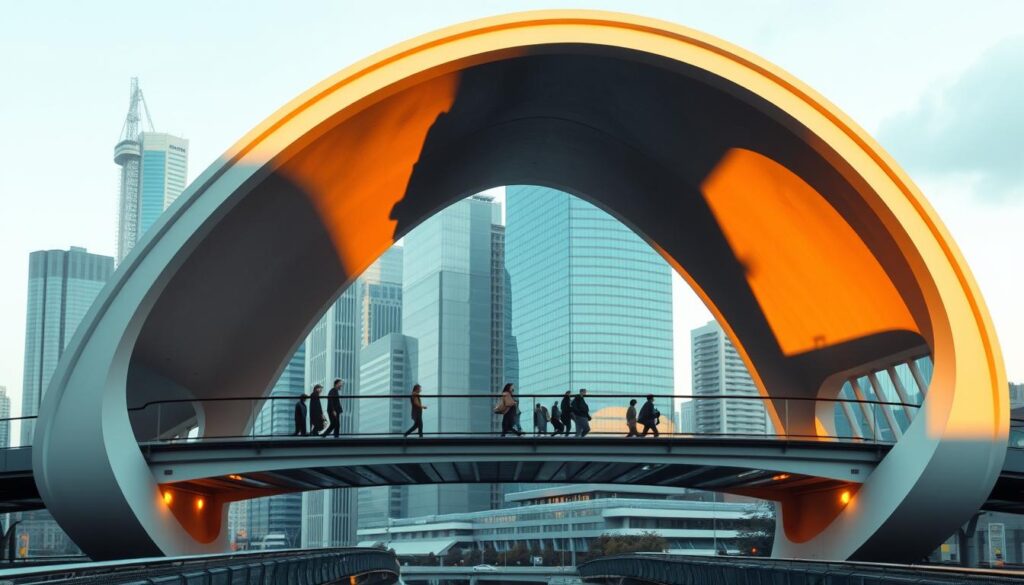
Arch Bridges
Arch bridges feature a curved design that provides strength and aesthetic appeal. They can be made from various materials, including steel and concrete. Arch bridges are often used in scenic areas where their design can be fully appreciated.
Beam Bridges
Beam bridges are straightforward in design, consisting of horizontal beams supported at each end. They are simple to construct and maintain, making them a cost-effective option for many locations.
Cable-Stayed Bridges
Cable-stayed bridges are characterized by their use of cables directly connected to the bridge deck. They offer a modern and sleek appearance, often becoming landmarks in their own right. For more information on the different types of pedestrian bridges, you can visit Roseke’s guide.
The choice of pedestrian bridge type depends on several factors, including the span length, environmental conditions, and aesthetic considerations. Understanding these factors is crucial for effective pedestrian bridge construction.
- Suspension bridges for long spans and iconic designs
- Arch bridges for strength and aesthetic appeal
- Beam bridges for simplicity and cost-effectiveness
- Cable-stayed bridges for modern appeal and landmark potential
Each type of pedestrian bridge contributes to modern pedestrian bridge design and pedestrian bridge construction practices, enhancing urban connectivity and safety.
Key Principles of Effective Design
A well-designed pedestrian bridge must satisfy the trifecta of safety, accessibility, and aesthetic appeal to truly enhance urban connectivity. This balance is crucial for creating sustainable pedestrian bridge designs that not only serve their purpose but also become iconic pedestrian bridge designs that define the character of a city.
Good bridge design exemplifies the three criteria of structural art: minimum use of materials, minimum cost, and maximum aesthetic expression. This principle guides designers in creating bridges that are not only functional but also visually appealing and environmentally friendly.
Safety Considerations
Safety is paramount in pedestrian bridge design. This includes ensuring structural integrity, providing adequate lighting, and incorporating safety barriers to prevent accidents. Designers must also consider the bridge’s resilience to natural disasters and other potential hazards.
Accessibility Features
Accessibility is another critical aspect of pedestrian bridge design. Bridges should be designed to be inclusive, with features such as ramps or elevators for individuals with disabilities. The surface material and gradient of the bridge are also important considerations to ensure ease of use for all pedestrians.
Aesthetic Appeal
The aesthetic appeal of a pedestrian bridge can significantly impact its surroundings. An iconic pedestrian bridge design can become a landmark, enhancing the urban landscape and fostering community pride. Designers achieve this through careful selection of materials, colors, and shapes that complement the existing architecture.
In conclusion, the key principles of effective pedestrian bridge design revolve around safety, accessibility, and aesthetic appeal. By balancing these elements, designers can create sustainable and iconic pedestrian bridges that enhance urban connectivity and contribute to the beauty of the urban environment.
Materials Used in Pedestrian Bridge Construction
Selecting the right material is crucial in pedestrian bridge engineering, with options ranging from traditional steel and concrete to innovative composite materials. The choice of material significantly influences the bridge’s durability, maintenance needs, and aesthetic appeal.
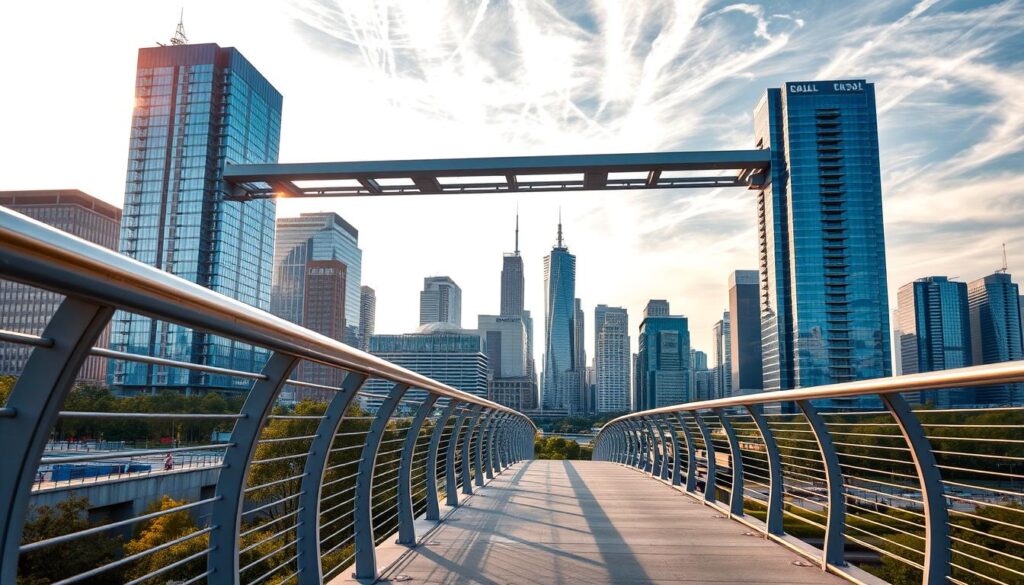
Steel
Steel is a popular choice for pedestrian bridges due to its high strength-to-weight ratio, flexibility, and durability. It allows for the creation of long spans and complex designs, making it ideal for urban environments where visual impact is considered.
Advantages of Steel:
- High tensile strength
- Flexibility in design
- Durability and resistance to weathering
Concrete
Concrete is another widely used material in pedestrian bridge construction, known for its versatility and cost-effectiveness. It can be molded into various shapes and forms, allowing for a range of aesthetic possibilities.
Benefits of Concrete:
- High compressive strength
- Low maintenance requirements
- Aesthetic flexibility
Timber
Timber is a sustainable and visually appealing material for pedestrian bridges, offering a natural look that can blend with or stand out from the surrounding environment. Modern timber treatment techniques have significantly improved its durability.
Advantages of Timber:
- Sustainability and eco-friendliness
- Aesthetic appeal
- Potential for local sourcing
Composite Materials
Composite materials, made from a combination of different materials such as fiber-reinforced polymers (FRP), offer exceptional durability, low maintenance, and resistance to corrosion. They are particularly useful in harsh environmental conditions.
Benefits of Composite Materials:
- High durability and resistance to corrosion
- Low maintenance needs
- Lightweight
Examples of successful pedestrian bridge constructions can be seen in projects like the Kusugibashi Bridge, rebuilt with cypress balustrades to protect it from future risks, and the Hangzhou Riverfront Public Space’s Silk Bridge, which showcases urban connectivity through waterfront revitalization. These examples demonstrate the importance of material selection in achieving both functional and aesthetic goals in pedestrian bridge design.
Environmental Impact and Sustainability
Incorporating eco-friendly materials and green design strategies is essential for sustainable pedestrian bridges. As cities grow and urbanization increases, the need for environmentally conscious infrastructure becomes more pressing.
The Donnguan Central Area Slow-Traffic Bridge is a prime example of how connectivity and greenery can be addressed simultaneously, aiming to revitalize interrupted green spaces and enhance the urban fabric. Such projects highlight the potential for pedestrian bridges to not only connect communities but also to contribute to urban sustainability.
Eco-friendly Materials
The choice of materials plays a crucial role in determining the environmental impact of a pedestrian bridge. Eco-friendly materials such as recycled steel, sustainably sourced timber, and low-carbon concrete can significantly reduce the carbon footprint of these structures.
“Using locally sourced materials can also reduce transportation emissions, further enhancing the sustainability of the bridge,” notes an expert in sustainable design. The use of such materials is a key aspect of modern pedestrian bridge design, where functionality meets environmental responsibility.
- Recycled steel reduces waste and conserves raw materials.
- Sustainably sourced timber supports responsible forestry practices.
- Low-carbon concrete minimizes the carbon footprint of the structure.
Green Design Strategies
Beyond materials, the design itself can incorporate green strategies to enhance sustainability. This includes integrating vegetation into the bridge structure, using energy-efficient lighting, and designing for longevity to reduce the need for frequent repairs or replacements.
A notable example of green design is the incorporation of green roofs or living walls into pedestrian bridge design. These features not only provide insulation and reduce energy consumption but also create habitats for local wildlife, enhancing urban biodiversity.
“Green infrastructure, such as green roofs and walls, can play a significant role in mitigating the urban heat island effect and improving air quality.”
By adopting these strategies, pedestrian bridges can become integral components of urban ecosystems, supporting both human connectivity and environmental sustainability.
Integrating Technology in Bridge Design
The use of innovative technologies is transforming the landscape of pedestrian bridge architecture. By incorporating advanced tools and methodologies, designers can create bridges that are not only aesthetically pleasing but also highly functional and efficient.
One notable example is the Yamma Pedestrian Bridge project, which utilized parametric design methodologies and cutting-edge tools like Rhino and Grasshopper. This approach set a new standard for efficiency and precision in engineering projects, demonstrating the potential of technology in enhancing bridge design.
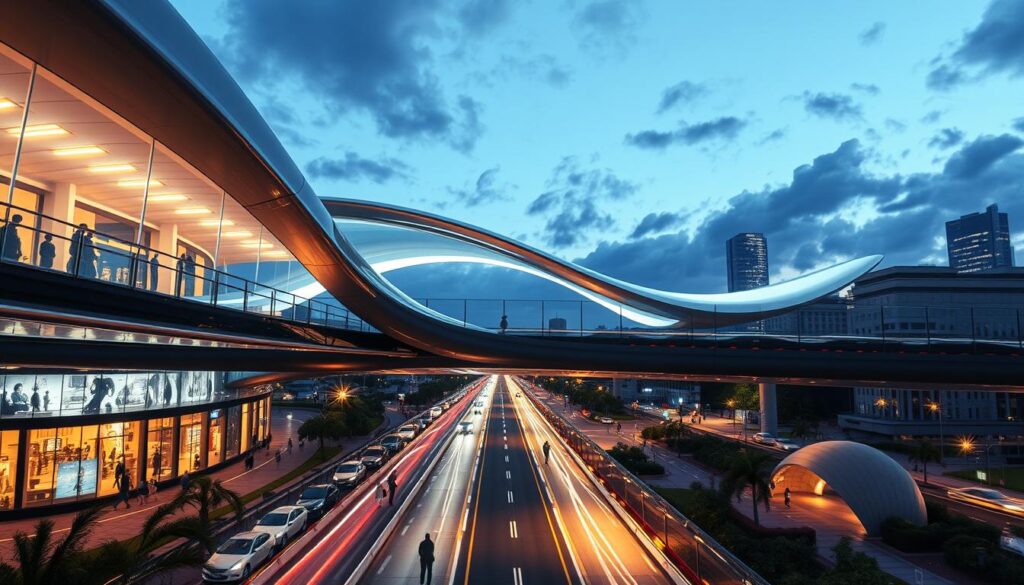
Smart Bridge Features
Smart bridge features are becoming increasingly popular in modern pedestrian bridge design. These features include integrated lighting systems, real-time monitoring, and energy-harvesting technologies. For instance, some bridges now incorporate energy-harvesting technologies that capture kinetic energy from foot traffic or environmental factors to power lighting and other systems.
To learn more about the application of AI in bridge design, you can read about the AI-augmented designing of a pedestrian bridge in, which showcases innovative approaches to bridge design.
Monitoring Systems
Monitoring systems play a crucial role in ensuring the safety and longevity of pedestrian bridges. These systems can detect structural issues early, allowing for timely maintenance and repairs. Advanced monitoring systems use sensors to track various parameters, such as stress, strain, and environmental conditions, providing valuable data for bridge management.
The integration of technology in bridge design is not only enhancing the functionality and safety of pedestrian bridges but also contributing to their sustainability and aesthetic appeal.
Bridging Communities: Social Benefits
By designing pedestrian bridges with community needs in mind, cities can enhance social cohesion and urban livability. Pedestrian bridges are more than just connectors; they are vibrant spaces that foster community interaction and a sense of belonging.
Promoting Walkability
Pedestrian bridges play a crucial role in promoting walkability within urban environments. By providing safe and accessible crossing points, they encourage residents to explore their surroundings on foot, thereby improving public health and reducing reliance on motorized transport.
- Enhancing connectivity between neighborhoods
- Encouraging physical activity among residents
- Reducing traffic congestion by providing alternative routes
Enhancing Local Businesses
The presence of well-designed pedestrian bridges can significantly boost local businesses. By increasing foot traffic, these bridges bring potential customers to local shops and services, thereby stimulating economic activity.
“The revitalization of urban waterways and the construction of pedestrian bridges have been instrumental in the resurgence of local economies, as seen in the case of the Vlasburg Bridge.”
Moreover, pedestrian bridges can become landmarks in their own right, attracting visitors and enhancing the overall appeal of the area.
Key benefits include:
- Increased visibility for local businesses
- Enhanced aesthetic appeal of the urban landscape
- Potential for increased tourism
In conclusion, the social benefits of pedestrian bridges are multifaceted, ranging from promoting walkability to enhancing local businesses. As cities continue to evolve, the importance of incorporating community needs into urban pedestrian bridge design cannot be overstated.
Case Studies of Iconic Pedestrian Bridges
Iconic pedestrian bridges have revolutionized urban landscapes, providing not only functional connectivity but also becoming landmarks in their own right. These structures showcase exceptional design and engineering, transforming the way cities are experienced.
The High Line, New York City
The High Line is a prime example of innovative pedestrian bridge design, elevated above the city streets on an abandoned rail line. It has become a model for urban renewal, demonstrating how disused infrastructure can be repurposed for public benefit. The High Line’s design incorporates native plant species, public art installations, and numerous access points, making it a vibrant public space.
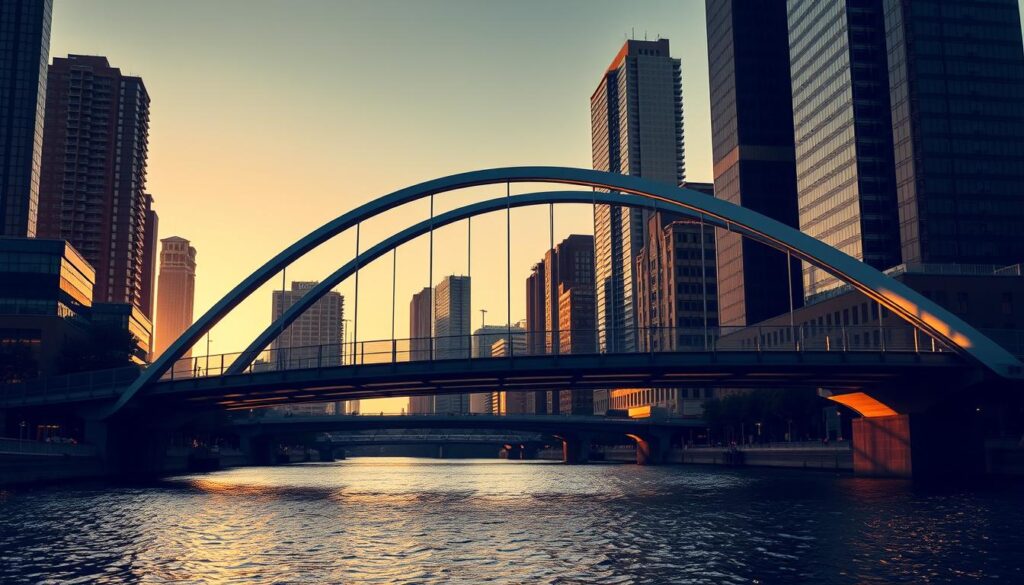
Millennium Bridge, London
Opened in 2000, the Millennium Bridge is a striking example of modern pedestrian bridge engineering. Its sleek, minimalist design has made it a popular tourist destination. The bridge’s unique ‘blade-like’ profile has become synonymous with London’s riverfront. Despite initial issues with wobbling, engineering solutions were implemented to stabilize the structure, ensuring its safety and longevity.
Ponte dei Sospiri, Venice
Ponte dei Sospiri, or Bridge of Sighs, is a historic pedestrian bridge in Venice, Italy. Built in the 17th century, it connects the Doge’s Palace to the prison, symbolizing the last view of freedom for prisoners. The bridge’s Baroque design and picturesque location make it an iconic Venetian landmark. Its design has influenced numerous other bridges and structures, showcasing the enduring appeal of traditional craftsmanship in pedestrian bridge construction.
These case studies highlight the diverse ways in which iconic pedestrian bridges can enhance urban environments. From modern engineering feats to historical landmarks, these structures play a crucial role in shaping the identity and connectivity of cities.
Regulatory Standards for Pedestrian Bridges
The regulatory framework for pedestrian bridges encompasses various standards to ensure their safety, accessibility, and sustainability. These standards are crucial for guiding the design and construction processes to meet the required safety and quality benchmarks.
Building Codes
Building codes are a set of regulations that govern the design, construction, and maintenance of pedestrian bridges. These codes ensure that bridges are structurally sound and safe for use. They cover aspects such as load capacity, material specifications, and structural integrity. For instance, the International Building Code (IBC) provides comprehensive guidelines that are widely adopted in the United States.
Compliance with building codes is not only mandatory but also essential for ensuring the longevity and safety of pedestrian bridges. It involves regular inspections and assessments to identify and rectify any potential issues before they become major problems.
Safety Regulations
Safety regulations are a critical component of the regulatory standards for pedestrian bridges. These regulations are designed to protect users from potential hazards and ensure a safe crossing experience. They include requirements for railing heights, lighting, and surface materials to prevent slips, trips, and falls.
Moreover, safety regulations often mandate regular maintenance schedules and inspections to identify and address any wear and tear or damage. This proactive approach helps in maintaining the structural integrity and safety of the bridges over time.
In conclusion, regulatory standards for pedestrian bridges, including building codes and safety regulations, play a vital role in ensuring their safety, accessibility, and sustainability. By adhering to these standards, designers and constructors can create bridges that not only serve their purpose but also contribute to the aesthetic and functional quality of urban environments.
Cost Considerations in Design and Construction
Effective cost management is crucial in pedestrian bridge projects, balancing budget constraints with design and safety requirements. The cost of pedestrian bridge construction varies widely depending on materials, design complexity, and labor costs.
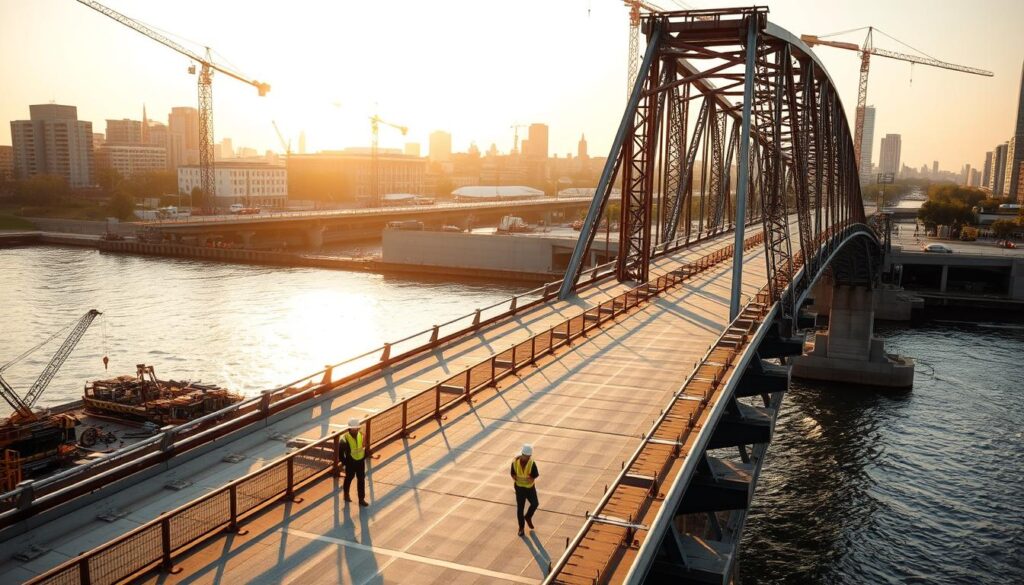
Budgeting for Materials
The choice of materials significantly impacts the overall cost of a pedestrian bridge. Steel, concrete, and timber are common materials used, each with its own cost implications.
- Steel is durable and can be used for complex designs but is generally more expensive.
- Concrete is versatile and can be more cost-effective, especially for larger structures.
- Timber offers a natural aesthetic and can be less expensive than steel, but it requires more maintenance.
| Material | Cost per Unit | Durability |
|---|---|---|
| Steel | $500/ton | High |
| Concrete | $150/cubic yard | High |
| Timber | $3/board foot | Medium |
Labor Costs
Labor costs are another significant factor in the overall cost of pedestrian bridge construction. The complexity of the design and the location of the project can influence labor costs.
To manage labor costs effectively, project managers can:
- Plan the construction schedule carefully to minimize delays.
- Use local labor to reduce relocation costs.
- Invest in training to improve worker efficiency.
By understanding and managing both material and labor costs, it’s possible to construct pedestrian bridges that are not only safe and functional but also cost-effective.
Community Involvement in Design Process
Incorporating community feedback into the design process is crucial for creating pedestrian bridges that are both functional and appreciated by locals. Community involvement ensures that the bridge meets the needs and expectations of its users, fostering a sense of ownership among community members.
Engaging Local Stakeholders
Engaging local stakeholders is a vital step in the design process. It involves identifying and collaborating with individuals and groups who have a vested interest in the project. This can include local residents, business owners, and community leaders. By engaging stakeholders, designers can gain valuable insights into the community’s needs and preferences, leading to more successful and acceptable designs. For instance, stakeholders can provide input on the bridge’s design, suggesting features such as improved lighting, artistic elements, or enhanced accessibility.
“Community involvement is not just about informing the public; it’s about engaging them in a meaningful way to shape the project.”
This approach not only enhances the design but also builds trust within the community.
Conducting Surveys
Conducting surveys is another effective method for gathering community input. Surveys can be distributed online or in-person, allowing community members to share their thoughts and suggestions on the proposed design. The data collected from surveys can help identify common themes and preferences, informing the design decisions. For example, a survey might reveal that the community prioritizes sustainability and aesthetic appeal in the bridge’s design.
| Community Input | Design Feature | Benefit |
|---|---|---|
| Improved Lighting | Enhanced Safety Features | Increased Security at Night |
| Artistic Elements | Aesthetic Appeal | Community Pride and Identity |
| Accessibility Features | Inclusive Design | Better Accessibility for All Users |
By engaging local stakeholders and conducting surveys, designers can create pedestrian bridges that are not only functional but also innovative and community-centric, reflecting the principles of innovative pedestrian bridge design and enhancing the overall pedestrian bridge architecture.
Maintenance and Longevity of Pedestrian Bridges
Ensuring the longevity of pedestrian bridges requires a proactive approach to maintenance. Regular inspections and long-term planning are essential for maintaining the structural integrity and longevity of these critical infrastructure components.
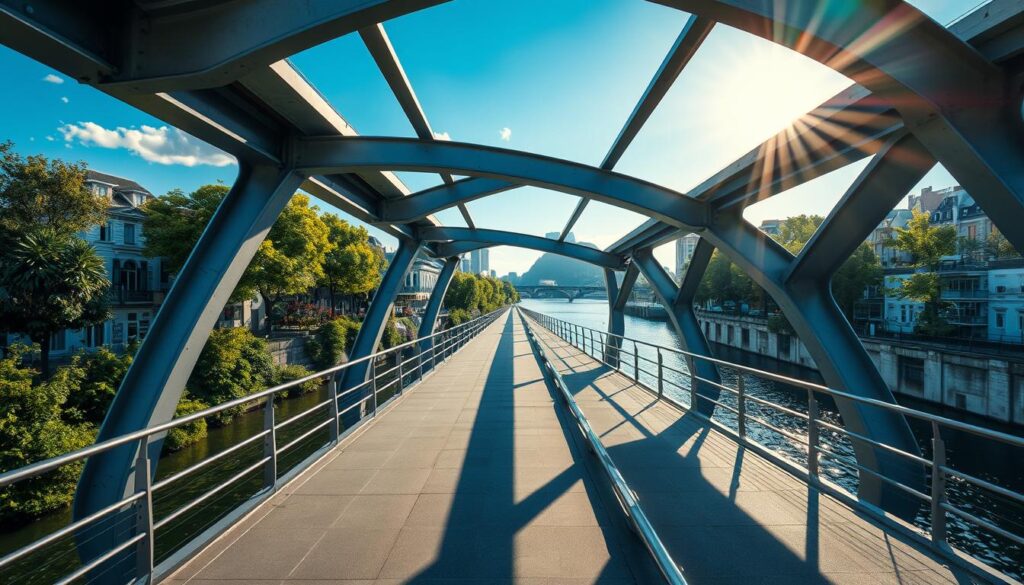
Regular Inspections
Regular inspections are the cornerstone of effective maintenance for pedestrian bridges. These inspections help identify potential issues before they become major problems, ensuring the bridge remains safe for users. According to experts, “Regular inspections are crucial for detecting early signs of deterioration, allowing for timely interventions that can significantly extend the lifespan of a pedestrian bridge”
.
During inspections, engineers look for signs of wear and tear, such as cracks in the structure, corrosion of metal components, and damage from environmental factors. Advanced technologies, including drones and sensor systems, are increasingly being used to enhance the inspection process, providing more detailed and accurate assessments.
Long-term Planning
Long-term planning is equally important for the maintenance of pedestrian bridges. This involves developing a comprehensive maintenance schedule that includes regular inspections, repairs, and replacements as needed. Effective long-term planning also considers factors such as environmental impact, user needs, and budget constraints.
A well-planned maintenance strategy not only ensures the longevity of the bridge but also helps in optimizing resources. As noted by a veteran bridge designer, “A proactive maintenance approach can significantly reduce long-term costs by preventing major repairs and extending the bridge’s lifespan.”
By combining regular inspections with long-term planning, it’s possible to maintain pedestrian bridges in a condition that is both safe and functional, supporting the needs of the community while minimizing the need for costly repairs.
Future Trends in Pedestrian Bridge Design
The design of pedestrian bridges is on the cusp of a revolution, driven by innovative designs and the need to adapt to climate change. As cities continue to grow and evolve, the role of pedestrian bridges in enhancing urban connectivity and promoting sustainable development is becoming increasingly important.
According to a report on sustainability in pedestrian bridge design, the integration of eco-friendly materials and green design strategies is crucial for reducing the environmental impact of these structures.
Innovative Designs
Innovative designs are transforming the landscape of pedestrian bridge construction. These designs not only enhance the aesthetic appeal of the bridges but also improve their functionality and sustainability. Some of the key trends include:
- Use of sustainable materials and construction techniques
- Incorporation of green spaces and landscaping
- Integration of renewable energy sources, such as solar panels
- Designs that promote user experience and community engagement
As noted by experts, “The future of pedestrian bridge design lies in creating structures that are not only functional but also contribute to the beauty and sustainability of our urban environments.”
“The bridge is a symbol of connection, not just between two physical places, but between people and their environment.”
Adaptation to Climate Change
Adapting to climate change is a critical aspect of future pedestrian bridge design. Rising sea levels, increased precipitation, and extreme weather events are some of the challenges that designers must address. Strategies for adaptation include:
| Design Strategy | Description | Benefits |
|---|---|---|
| Elevated Design | Raising the bridge to protect against flooding | Reduces risk of damage from floodwaters |
| Resilient Materials | Using materials that can withstand extreme weather conditions | Enhances durability and reduces maintenance needs |
| Flexible Structures | Designing bridges that can flex and adapt to changing environmental conditions | Improves structural integrity and safety |
By incorporating these strategies, pedestrian bridges can not only survive but thrive in the face of climate change, ensuring continued connectivity and accessibility for urban residents.
The future of pedestrian bridge design is bright, with a focus on creating iconic and sustainable structures that enhance urban landscapes. As cities continue to evolve, the importance of well-designed pedestrian bridges will only continue to grow.
Conclusion: The Future of Urban Connectivity
The design of pedestrian bridges is crucial for creating vibrant, interconnected urban environments. As cities continue to grow and evolve, the importance of pedestrian bridge design in enhancing urban connectivity becomes increasingly evident.
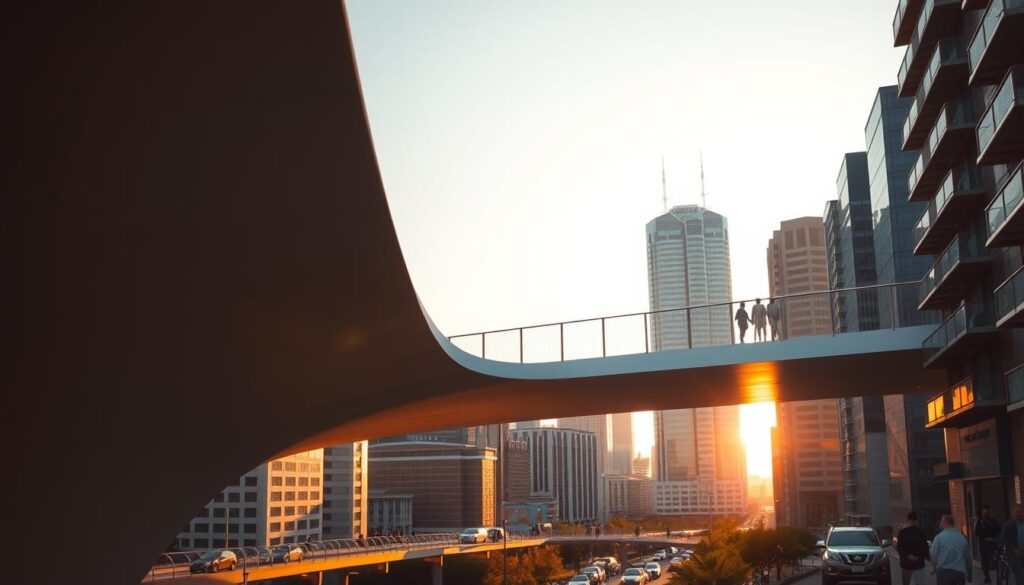
Summary of Key Points
Throughout this article, we have explored various aspects of pedestrian bridge design, from the types of bridges and materials used to the integration of technology and sustainability. Key takeaways include:
- The significance of accessibility and safety in bridge design.
- The role of innovative materials and sustainable practices in modern bridge construction.
- The impact of pedestrian bridge architecture on urban aesthetics and community engagement.
For more insights into innovative civil engineering projects, including pedestrian bridges, visit top civil engineering firms.
Call to Action for Urban Planners
As urban planners, you have the opportunity to shape the future of urban connectivity through thoughtful and innovative pedestrian bridge design. We encourage you to:
- Prioritize sustainability and accessibility in your designs.
- Explore new materials and technologies that can enhance bridge functionality and aesthetic appeal.
- Engage with local communities to understand their needs and preferences.
By doing so, you can create pedestrian bridges that not only connect physical spaces but also foster vibrant, inclusive communities.
Resources for Further Reading
For those interested in delving deeper into the world of pedestrian bridge design, numerous resources are available to expand your knowledge. Exploring these resources can provide valuable insights into pedestrian bridge engineering and innovative pedestrian bridge design.
Academic Resources
Books and journals are excellent sources for in-depth information on the subject. Publications on structural engineering and design principles can offer a comprehensive understanding of pedestrian bridge construction. Research papers and case studies on successful pedestrian bridges can also provide inspiration for innovative designs.
Professional Development Opportunities
Online courses and workshops focused on pedestrian bridge engineering and design can help professionals stay updated on the latest trends and technologies. These educational resources can range from foundational courses to advanced seminars, covering topics such as sustainable design and advanced materials.
